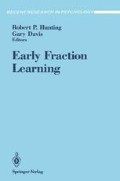Abstract
A group of six second grade children (average age 7 years 5 months) and their class teacher, were sitting around a table. On the table were arrangements of small wooden objects - mostly representations of animals There were two rabbits, four bears, six roosters, eight trees, 10 peacocks, and 12 worms. Starting with the two rabbits, the teacher had introduced each larger set in turn, asking a child to divide the set of objects in half, and to write symbols for the number of objects in each subset. The children offered their own interpretations for each partition, but through discussion and assistance most children, in the end, had written the sequence of fractions \( \frac{1}{2},\frac{2}{4},\frac{3}{6},\frac{4}{8},\frac{5}{{10}},\frac{6}{{12}}\) The teacher then said: “You have told me that each is a half of their combined total. How can these all be halves when we have got different numbers in each group?” In this instant those children were brought face to face with the possibility of developing a deeper interpretation of the fraction one half: that of a meta-relation.
Access this chapter
Tax calculation will be finalised at checkout
Purchases are for personal use only
Preview
Unable to display preview. Download preview PDF.
References
Bigelow, J. C. (1988). The reality of numbers. Oxford: Clarendon.
Bigelow, J. C., Davis, G. E., & Hunting, R. P. (April, 1989 ). Some remarks on the homology and dynamics of rational number learning. Paper presented at the Research Pre-session of the National Council of Teachers of Mathematics Annual Meeting, Orlando Florida.
Bigelow, J. C., & Pargetter, R. J. (1991). Science and necessity. Cambridge: Cambridge University Press.
Davis, G. E. (1988). The fraction machines: A research and classroom tool for fraction learning. Written in GFA compiled Basic for Atari ST machines. Bundoora: La Trobe University.
Davis, G. E., & Hunting, R. P. (1990). Spontaneous partitioning: Preschoolers and discrete items. Educational Studies in Mathematics, 21, 367–374.
Davis, G. E., & Pitkethly, A. (1990). Cognitive aspects of sharing. Journal for Research in Mathematics Education, 21 (2), 145–153.
Euler, L. (1822). Elements of algebra (trans. by J. Hewlett, 3rd Edition ). London: J. Jonson.
Freudenthal, H. (1983). Didactical phenomenology of mathematical structures. Dortrecht: D. Reidel.
Hunting, R. P. (1983). How children account for fraction equivalence. In R. Hershkowitz (Ed.). Proceedings of the Seventh International Conference for the Psychology of Mathematics Education (pp. 176–181 ). Rehovot Israel: Dept of Science Teaching, Weizmann Institute of Science.
Hunting, R. P. (1986). Rachel’s schemes for constructing fraction knowledge. Educational Studies in Mathematics, 17, 49–66.
Hunting, R.P. (1984). Understanding equivalent fractions. Journal of Science and Mathematics Education in Southeast Asia, 7 (1), 26–33.
Hunting, R. P., Bigelow, J. C., & Davis, G. E. (1989). The trouble with fractions: Can computer-based learning environments help? In B. Doig (Ed.), Every one counts (pp. 130–133 ). Parkville: Mathematical Association of Victoria.
Hunting, R P., & Korbosky, R. K. (1990). Context and process in fraction learning. International Journal of Mathematical Education in Science and Technology, 21 (6), 929–948.
Hunting, R. P., & Sharpley, C. F. (1988). Fraction knowledge in preschool children. Journal for Research in Mathematics Education, 19 (2), 175–180.
Kieren, T., & Nelson, D. (1978). The operator construct of rational numbers in childhood and adolescence - An exploratory study. The Alberta Journal of Educational Research, 24, 1.
Kieren, T., & Southwell, B. (1979). The development in children and adolescents of the construct of rational numbers as operators. The Alberta Journal of Educational Research, 25, 4.
National Council of Teachers of Mathematics. (1989). Curriculum and evaluation standards for school mathematics. Reston VA: Author.
Newton, J. (1728). Arithmetica universalis ( 2nd ed. ). London: Longman
Southwell, B. (1980). A preliminary report on the development of the operator construct of rational number in Papua New Guinea. In B. Foster (Ed.), Research in Mathematics Education in Australia Vol. 1 (pp. 187–199 ). Hobart: The University of Tasmania.
Editor information
Editors and Affiliations
Rights and permissions
Copyright information
© 1991 Springer-Verlag New York, Inc.
About this chapter
Cite this chapter
Hunting, R.P., Davis, G., Bigelow, J.C. (1991). Higher Order Thinking in Young Children’s Engagements with a Fraction Machine. In: Hunting, R.P., Davis, G. (eds) Early Fraction Learning. Recent Research in Psychology. Springer, New York, NY. https://doi.org/10.1007/978-1-4612-3194-3_5
Download citation
DOI: https://doi.org/10.1007/978-1-4612-3194-3_5
Publisher Name: Springer, New York, NY
Print ISBN: 978-0-387-97641-9
Online ISBN: 978-1-4612-3194-3
eBook Packages: Springer Book Archive

